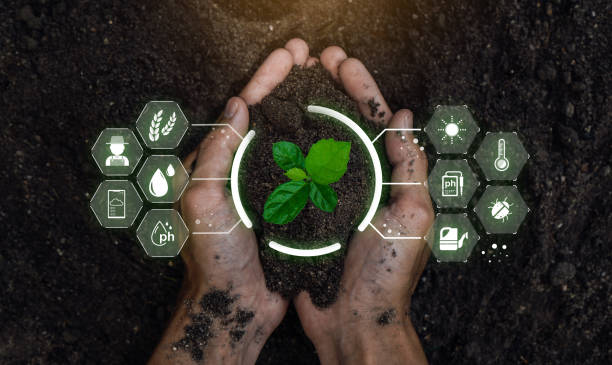
Digimagaz.com – Technology has become an integral part of our lives, transforming various sectors, including agriculture. With the growing demand for sustainable and efficient farming practices, the integration of technology has revolutionized the agriculture industry. In this article, we will explore the role of technology in agriculture and how it is shaping the future of farming.
1. Precision Farming
Precision farming is a cutting-edge approach that utilizes advanced technologies such as GPS, sensors, and drones to optimize agricultural practices. These technologies allow farmers to monitor and manage their crops with precision, resulting in higher productivity and reduced resource wastage. Farmers can precisely apply fertilizers, water, and pesticides based on the specific needs of each plant, leading to improved crop quality and minimized environmental impact.
2. Internet of Things (IoT)
The Internet of Things (IoT) has transformed the way farmers collect and analyze data. IoT devices such as soil moisture sensors, weather stations, and smart irrigation systems enable farmers to gather real-time information about their crops and make data-driven decisions. By leveraging IoT, farmers can optimize irrigation schedules, detect diseases or pests early on, and automate various processes, ultimately increasing efficiency and reducing costs.
3. Robotics and Automation
Advancements in robotics and automation have brought significant changes to the agricultural landscape. Robots are now capable of performing various tasks, such as planting seeds, harvesting crops, and even monitoring livestock. These technologies not only reduce the dependency on manual labor but also enhance productivity and precision. Automated systems can operate 24/7, ensuring timely and accurate execution of farming operations.
4. Big Data and Analytics
The availability of vast amounts of agricultural data has opened doors to predictive analytics and data-driven decision-making. By harnessing big data and analytics, farmers can analyze historical and real-time data to gain insights into crop performance, soil conditions, market trends, and more. This information empowers farmers to optimize their strategies, mitigate risks, and maximize yields.
5. Vertical Farming
Vertical farming is a revolutionary concept that involves growing crops in vertically stacked layers, utilizing indoor environments and controlled conditions. This technology is particularly beneficial in urban areas with limited space and resources. Vertical farming systems integrate advanced lighting, hydroponics, and climate control technologies to provide optimal growing conditions. By eliminating the need for vast expanses of land and reducing water usage, vertical farming offers a sustainable solution to meet the increasing demand for food.
The use of robotics and automation in agriculture offers numerous benefits, such as increased efficiency, improved productivity, and reduced labor costs. However, there are also several challenges and limitations associated with this technology. Here are some potential challenges to consider:
1. High Initial Investment: Implementing robotics and automation systems in agriculture requires a significant upfront investment. The cost of purchasing and maintaining the necessary equipment, such as robots, sensors, and control systems, can be a major barrier for small-scale farmers or those with limited financial resources.
2. Technical Complexity: Robotics and automation systems in agriculture involve advanced technology, including complex algorithms, machine learning, and computer vision. Farmers and agricultural workers need to acquire the necessary technical skills and knowledge to operate and maintain these systems effectively. Training and education may be required to ensure their proper implementation and utilization.
3. Adaptability to Dynamic Environments: Farms and agricultural settings are dynamic and ever-changing environments. Challenges arise from factors like varying weather conditions, unpredictable crop growth patterns, and diverse terrain. Designing robotic systems that can effectively adapt to these dynamic conditions and perform tasks accurately and efficiently can be a significant challenge.
4. Limited Crop Variety: Robotics and automation systems are typically designed for specific tasks and crops. The technology may be readily available for certain crops, such as row crops like corn or wheat, but less developed or unavailable for others. Adapting robotic systems to work with a wider variety of crops can present technical and logistical challenges.
5. Maintenance and Repairs: Like any machinery, robotics and automation systems require regular maintenance and occasional repairs. Ensuring that the equipment remains operational and minimizing downtime can be crucial for maintaining productivity. However, farmers may face challenges in accessing technical support, spare parts, or skilled technicians in remote or rural areas.
6. Ethical Considerations: The increasing use of robotics and automation in agriculture raises ethical concerns, particularly related to the displacement of human labor. As automation replaces certain jobs, it may have social and economic implications for farm workers and rural communities. Balancing the benefits of automation with the preservation of livelihoods and social well-being is an important consideration.
7. Regulatory and Legal Frameworks: The integration of robotics and automation in agriculture may require compliance with specific regulations and legal frameworks. As these technologies evolve, policymakers need to address issues related to safety, privacy, data management, and liability. Developing appropriate regulations and standards can be a complex and time-consuming process.
It’s important to recognize these challenges and limitations while also acknowledging the potential benefits of robotics and automation in agriculture. Overcoming these hurdles will require continued research, development, and collaboration among stakeholders, including farmers, technology providers, policymakers, and researchers.
The Future of Farming: Which Country Leads in Agricultural Technology?
The agricultural landscape is undergoing a profound transformation, with technology playing a pivotal role in enhancing productivity and sustainability. Among the nations embracing cutting-edge innovations, one stands out for its remarkable strides in agricultural technology. In this article, we will explore the leading country in agricultural technology, delve into the top agricultural products that dominate the fields of the United States, and provide insights into the thriving agricultural industry in the US.
Which Country Leads in Agricultural Technology?
When it comes to agricultural technology, the Netherlands emerges as a global powerhouse. Despite its relatively small size, the Netherlands has revolutionized traditional farming methods through the integration of advanced technologies. Precision agriculture, hydroponics, and automated systems are just a few examples of the innovative approaches Dutch farmers have adopted. Leveraging technologies such as drones, sensors, and data analytics, Dutch agriculture has become a model of efficiency and sustainability.
Top 5 Agricultural Products in the United States:
1. Corn: Corn cultivation stands as the cornerstone of American agriculture. Widely used for livestock feed, ethanol production, and a myriad of food products, corn is a versatile crop that dominates the agricultural landscape across the United States.
2. Soybeans: Soybeans are a vital cash crop in the US. Rich in protein, they are a fundamental component of livestock feed and contribute significantly to the nation’s agricultural exports.
3. Wheat: Wheat farming is prevalent in several US states. This essential cereal grain serves as a key ingredient in numerous food products, making it a crucial commodity within the agricultural industry.
4. Cattle and Calves: Livestock farming, particularly cattle and calves, plays a pivotal role in American agriculture. The US is a leading producer of beef, supplying both domestic and international markets with high-quality meat products.
5. Poultry: The poultry industry, encompassing chicken and turkey farming, thrives in the United States. Poultry products are consumed nationwide, contributing significantly to the country’s agricultural economy.
The Thriving Agricultural Industry in the US:
The agricultural sector in the United States is not only characterized by its diverse range of products but also by its innovative practices. American farmers embrace technology to optimize crop yields, conserve resources, and minimize environmental impact. The industry’s advancements are a testament to the nation’s commitment to sustainable agriculture and food security.
In conclusion, the integration of advanced technology in agriculture continues to shape the future of farming globally. With nations like the Netherlands leading the way and the United States showcasing unparalleled agricultural diversity, the world is witnessing a transformative era in agriculture, where innovation and sustainability go hand in hand.








